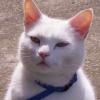So ... these important organs ... essential for organic function (life) are protected by four gods - the Sons of Horus. Then each of the sons of Horus are protected by a goddess. We have met two of these goddesses already - Isis and Nephthys. We know that Isis represents an 'up' phase of a cycle ... up into the light .. and that Nephthys represents a down phase ... into the dark. So we have organs and rhythmic up/down movement ... which supports the organs. In the case of the lungs its obvious that the breath is involved, Isis the in-breath and Nephthys the out.
The gods of the stomach and intestines are protected by Neith (the huntress goddess of the East) and by Serqet the scorpion goddess (the West). What is the rhythm of the digestive system? Peristalsis. A process of contraction and expansion which moves food through the gut and also clears the intestines even when not eating. It is a slow but permanent rhythm operating even when we haven't eaten and in sleep. Neith is contraction and Serqet expansion.
So we have two systems of rhythmic activity, one in the thorax and one in the abdomen. Both of which feed the heart (which has its own rhythm - the pulse).
We should also mention that the cerebro-spinal fluid has its own rhythm - which the Egyptians had observed when performing cranial surgery.
Grok on peristalsis:
[stylesheet-group="0"]{}
body{margin:0;}
button::-moz-focus-inner,input::-moz-focus-inner{border:0;padding:0;}
html{-ms-text-size-adjust:100%;-webkit-text-size-adjust:100%;-webkit-tap-highlight-color:rgba(0,0,0,0);}
input::-webkit-search-cancel-button,input::-webkit-search-decoration,input::-webkit-search-results-button,input::-webkit-search-results-decoration{display:none;}
[stylesheet-group="1"]{}
.css-146c3p1{background-color:rgba(0,0,0,0.00);border:0 solid black;box-sizing:border-box;color:rgba(0,0,0,1.00);display:inline;font:14px -apple-system,BlinkMacSystemFont,"Segoe UI",Roboto,Helvetica,Arial,sans-serif;list-style:none;margin:0px;padding:0px;position:relative;text-align:start;text-decoration:none;white-space:pre-wrap;word-wrap:break-word;}
.css-175oi2r{align-items:stretch;background-color:rgba(0,0,0,0.00);border:0 solid black;box-sizing:border-box;display:flex;flex-basis:auto;flex-direction:column;flex-shrink:0;list-style:none;margin:0px;min-height:0px;min-width:0px;padding:0px;position:relative;text-decoration:none;z-index:0;}
.css-1jxf684{background-color:rgba(0,0,0,0.00);border:0 solid black;box-sizing:border-box;color:inherit;display:inline;font:inherit;list-style:none;margin:0px;padding:0px;position:relative;text-align:inherit;text-decoration:none;white-space:inherit;word-wrap:break-word;}
.css-9pa8cd{bottom:0px;height:100%;left:0px;opacity:0;position:absolute;right:0px;top:0px;width:100%;z-index:-1;}
[stylesheet-group="2"]{}
.r-13awgt0{flex:1;}
.r-1adg3ll{display:block;}
.r-1jkafct{border-bottom-left-radius:2px;border-bottom-right-radius:2px;border-top-left-radius:2px;border-top-right-radius:2px;}
.r-1phboty{border-bottom-style:solid;border-left-style:solid;border-right-style:solid;border-top-style:solid;}
.r-1udh08x{overflow-x:hidden;overflow-y:hidden;}
.r-4iw3lz{border-bottom-width:0;border-left-width:0;border-right-width:0;border-top-width:0;}
.r-4qtqp9{display:inline-block;}
.r-6koalj{display:flex;}
.r-bztko3{overflow-x:visible;overflow-y:visible;}
.r-crgep1{margin:0px;}
.r-hvic4v{display:none;}
.r-krxsd3{display:-webkit-box;}
.r-rs99b7{border-bottom-width:1px;border-left-width:1px;border-right-width:1px;border-top-width:1px;}
.r-sdzlij{border-bottom-left-radius:9999px;border-bottom-right-radius:9999px;border-top-left-radius:9999px;border-top-right-radius:9999px;}
.r-t60dpp{padding:0px;}
.r-wwvuq4{padding:0;}
.r-xoduu5{display:inline-flex;}
.r-ywje51{margin:auto;}
.r-z2wwpe{border-bottom-left-radius:4px;border-bottom-right-radius:4px;border-top-left-radius:4px;border-top-right-radius:4px;}
[stylesheet-group="2.1"]{}
.r-1559e4e{padding-bottom:2px;padding-top:2px;}
.r-1fkl15p{padding-left:32px;padding-right:32px;}
.r-3o4zer{padding-left:12px;padding-right:12px;}
.r-3pj75a{padding-left:16px;padding-right:16px;}
.r-cxgwc0{padding-left:24px;padding-right:24px;}
.r-dd0y9b{padding-bottom:20px;padding-top:20px;}
.r-ddtstp{margin-bottom:0px;margin-top:0px;}
.r-dp7rxi{padding-bottom:40px;padding-top:40px;}
.r-f8sm7e{margin-left:auto;margin-right:auto;}
.r-n7gxbd{padding-left:4px;padding-right:4px;}
.r-s49dbf{margin-bottom:1px;margin-top:1px;}
.r-sjygvo{padding-left:1em;padding-right:1em;}
[stylesheet-group="2.2"]{}
.r-15peodp{right:-9999px;}
.r-19qo34d{left:-9999px;}
.r-1ca1ndr{margin-left:0.5em;}
.r-1ez5h0i{margin-left:4px;}
.r-1gs4q39{margin-right:4px;}
.r-1kkk96v{margin-left:8px;}
.r-1kpi4qh{margin-left:0.075em;}
.r-1l2kgy{margin-right:0.5em;}
.r-1q6cnnd{right:-2px;}
.r-1wron08{margin-right:8px;}
.r-3t4u6i{margin-left:2px;}
.r-45ll9u{left:50%;}
.r-5f1w11{left:-2px;}
.r-k4bwe5{margin-right:0.075em;}
.r-o59np7{padding-right:8px;}
.r-ocobd0{right:50%;}
.r-qjj4hq{padding-left:8px;}
.r-x1x4zq{margin-right:2px;}
[stylesheet-group="3"]{}
.r-105ug2t{pointer-events:auto!important;}
.r-109y4c4{height:1px;}
.r-10ptun7{height:16px;}
.r-10v3vxq{transform:scaleX(-1);}
.r-117bsoe{margin-bottom:20px;}
.r-11c0sde{margin-top:24px;}
.r-11j9u27{visibility:hidden;}
.r-12181gd{box-shadow:0 0 2px rgba(0,0,0,0.03) inset;}
.r-12sks89{min-height:22px;}
.r-12vffkv>*{pointer-events:auto;}
.r-12vffkv{pointer-events:none!important;}
.r-12ym1je{width:18px;}
.r-135wba7{line-height:24px;}
.r-13qz1uu{width:100%;}
.r-13wfysu{-webkit-text-decoration-line:none;text-decoration-line:none;}
.r-146iojx{max-width:300px;}
.r-1472mwg{height:24px;}
.r-14j79pv{color:rgba(83,100,113,1.00);}
.r-14lw9ot{background-color:rgba(255,255,255,1.00);}
.r-15ysp7h{min-height:32px;}
.r-16dba41{font-weight:400;}
.r-16y2uox{flex-grow:1;}
.r-176fswd{transform:translateX(-50%) translateY(-50%);}
.r-1777fci{justify-content:center;}
.r-17bb2tj{animation-duration:0.75s;}
.r-17leim2{background-repeat:repeat;}
.r-17s6mgv{justify-content:flex-end;}
.r-18jsvk2{color:rgba(15,20,25,1.00);}
.r-18tzken{width:56px;}
.r-18u37iz{flex-direction:row;}
.r-18yzcnr{height:22px;}
.r-19wmn03{width:20px;}
.r-19yznuf{min-height:52px;}
.r-1abnn5w{animation-play-state:paused;}
.r-1acpoxo{width:36px;}
.r-1ad0z5i{word-break:break-all;}
.r-1awozwy{align-items:center;}
.r-1b43r93{font-size:14px;}
.r-1betnmo{max-width:672px;}
.r-1blnp2b{width:72px;}
.r-1blvdjr{font-size:23px;}
.r-1ceczpf{min-height:24px;}
.r-1cwl3u0{line-height:16px;}
.r-1d2f490{left:0px;}
.r-1ddef8g{-webkit-text-decoration-line:underline;text-decoration-line:underline;}
.r-1dn12g7{line-height:48px;}
.r-1ebb2ja{list-style:none;}
.r-1ff274t{text-align:right;}
.r-1gkfh8e{font-size:11px;}
.r-1h0z5md{justify-content:flex-start;}
.r-1h8ys4a{padding-top:4px;}
.r-1hjwoze{height:18px;}
.r-1iln25a{word-wrap:normal;}
.r-1inkyih{font-size:17px;}
.r-1ipicw7{width:300px;}
.r-1iusvr4{flex-basis:0px;}
.r-1janqcz{width:16px;}
.r-1jaylin{width:-webkit-max-content;width:-moz-max-content;width:max-content;}
.r-1k78y06{font-family:Tahoma, Arial, sans-serif;}
.r-1kihuf0{align-self:center;}
.r-1ldzwu0{animation-timing-function:linear;}
.r-1loqt21{cursor:pointer;}
.r-1mlwlqe{flex-basis:auto;}
.r-1mrlafo{background-position:0;}
.r-1muvv40{animation-iteration-count:infinite;}
.r-1mwlp6a{height:56px;}
.r-1nao33i{color:rgba(231,233,234,1.00);}
.r-1niwhzg{background-color:rgba(0,0,0,0.00);}
.r-1ny4l3l{outline-style:none;}
.r-1oifz5y{background-color:rgba(170,17,0,1.00);}
.r-1oszu61{align-items:stretch;}
.r-1otgn73{touch-action:manipulation;}
.r-1p0dtai{bottom:0px;}
.r-1pi2tsx{height:100%;}
.r-1ps3wis{min-width:44px;}
.r-1qd0xha{font-family:-apple-system,BlinkMacSystemFont,"Segoe UI",Roboto,Helvetica,Arial,sans-serif;}
.r-1qi8awa{min-width:36px;}
.r-1r5jyh0{min-height:130px;}
.r-1r8g8re{height:36px;}
.r-1s2hp8q{min-height:26px;}
.r-1sxrcry{background-size:auto;}
.r-1tl8opc{font-family:"Segoe UI",Meiryo,system-ui,-apple-system,BlinkMacSystemFont,sans-serif;}
.r-1to6hqq{background-color:rgba(255,212,0,1.00);}
.r-1ttztb7{text-align:inherit;}
.r-1udbk01{text-overflow:ellipsis;}
.r-1v2oles{top:50%;}
.r-1vmecro{direction:rtl;}
.r-1vr29t4{font-weight:800;}
.r-1wb8bfx{text-decoration-thickness:2px;}
.r-1wbh5a2{flex-shrink:1;}
.r-1wvb978{font-feature-settings:'ss01' on;}
.r-1wyyakw{z-index:-1;}
.r-1xcajam{position:fixed;}
.r-1xk2f4g{clip:rect(1px, 1px, 1px, 1px);}
.r-1xnzce8{-moz-user-select:text;-webkit-user-select:text;user-select:text;}
.r-1xvli5t{height:1.25em;}
.r-1y7e96w{min-width:22px;}
.r-1ye8kvj{max-width:600px;}
.r-1yef0xd{animation-name:r-11cv4x;}
.r-1yjpyg1{font-size:31px;}
.r-1ykxob0{top:60%;}
.r-2o02ov{margin-top:40px;}
.r-2tavb8{background-color:rgba(0,0,0,0.60);}
.r-2yi16{min-height:36px;}
.r-36ujnk{font-style:italic;}
.r-37tt59{line-height:32px;}
.r-3s2u2q{white-space:nowrap;}
.r-417010{z-index:0;}
.r-4gszlv{background-size:cover;}
.r-4hwcpe{font-family:Vazirmatn, Tahoma, Arial, sans-serif;}
.r-4wgw6l{min-width:32px;}
.r-54znze{color:rgba(239,243,244,1.00);}
.r-56xrmm{line-height:12px;}
.r-6026j{background-color:rgba(255,255,255,0.85);}
.r-633pao{pointer-events:none!important;}
.r-6416eg{-moz-transition-property:background-color, box-shadow;-webkit-transition-property:background-color, box-shadow;transition-property:background-color, box-shadow;}
.r-64el8z{min-width:52px;}
.r-7q8q6z{cursor:default;}
.r-8akbws{-webkit-box-orient:vertical;}
.r-8jfcpp{top:-2px;}
.r-92ng3h{width:1px;}
.r-a023e6{font-size:15px;}
.r-adyw6z{font-size:20px;}
.r-agouwx{transform:translateZ(0);}
.r-ah5dr5>*{pointer-events:none;}
.r-ah5dr5{pointer-events:auto!important;}
.r-aqfbo4{backface-visibility:hidden;}
.r-b88u0q{font-weight:700;}
.r-bcqeeo{min-width:0px;}
.r-bnwqim{position:relative;}
.r-bt1l66{min-height:20px;}
.r-bvlit7{margin-bottom:-12px;}
.r-clrlgt{animation-name:r-imtty0;}
.r-deolkf{box-sizing:border-box;}
.r-dflpy8{height:1.2em;}
.r-dnmrzs{max-width:100%;}
.r-ehq7j7{background-size:contain;}
.r-emqnss{transform:translateZ(0px);}
.r-eqz5dr{flex-direction:column;}
.r-ero68b{min-height:40px;}
.r-fdjqy7{text-align:left;}
.r-fm7h5w{font-family:"TwitterChirpExtendedHeavy","Verdana",-apple-system,BlinkMacSystemFont,"Segoe UI",Roboto,Helvetica,Arial,sans-serif;}
.r-h9hxbl{width:1.2em;}
.r-icoktb{opacity:0.5;}
.r-ifefl9{min-height:0px;}
.r-impgnl{transform:translateX(50%) translateY(-50%);}
.r-iphfwy{padding-bottom:4px;}
.r-ipm5af{top:0px;}
.r-jmul1s{transform:scale(1.1);}
.r-jwli3a{color:rgba(255,255,255,1.00);}
.r-kemksi{background-color:rgba(0,0,0,1.00);}
.r-lp5zef{min-width:24px;}
.r-lrsllp{width:24px;}
.r-lrvibr{-moz-user-select:none;-webkit-user-select:none;user-select:none;}
.r-m6rgpd{vertical-align:text-bottom;}
.r-majxgm{font-weight:500;}
.r-n6v787{font-size:13px;}
.r-nhe8su{animation-duration:0.5s;}
.r-nvplwv{animation-timing-function:ease-out;}
.r-nwxazl{line-height:40px;}
.r-o7ynqc{transition-duration:0.2s;}
.r-orgf3d{opacity:0;}
.r-peo1c{min-height:44px;}
.r-poiln3{font-family:inherit;}
.r-pp5qcn{vertical-align:-20%;}
.r-q4m81j{text-align:center;}
.r-qlhcfr{font-size:0.001px;}
.r-qvk6io{line-height:0px;}
.r-qvutc0{word-wrap:break-word;}
.r-rjixqe{line-height:20px;}
.r-rki7wi{bottom:12px;}
.r-s67bdx{font-size:48px;}
.r-sb58tz{max-width:1000px;}
.r-tjvw6i{text-decoration-thickness:1px;}
.r-u6sd8q{background-repeat:no-repeat;}
.r-u8s1d{position:absolute;}
.r-ueyrd6{line-height:36px;}
.r-uho16t{font-size:34px;}
.r-vkv6oe{min-width:40px;}
.r-vlxjld{color:rgba(247,249,249,1.00);}
.r-vqxq0j{border:0 solid black;}
.r-vrz42v{line-height:28px;}
.r-vvn4in{background-position:center;}
.r-wy61xf{height:72px;}
.r-x3cy2q{background-size:100% 100%;}
.r-x572qd{background-color:rgba(247,249,249,1.00);}
.r-xigjrr{-webkit-filter:blur(4px);filter:blur(4px);}
.r-yc9v9c{width:22px;}
.r-yfoy6g{background-color:rgba(21,32,43,1.00);}
.r-yn5ncy{animation-fill-mode:both;}
.r-yy2aun{font-size:26px;}
.r-yyyyoo{fill:currentcolor;}
.r-z7pwl0{max-width:700px;}
.r-z80fyv{height:20px;}
.r-zchlnj{right:0px;}
@-webkit-keyframes r-11cv4x{0%{transform:rotate(0deg);}100%{transform:rotate(360deg);}}
@-webkit-keyframes r-imtty0{0%{opacity:0;}100%{opacity:1;}}
@keyframes r-11cv4x{0%{transform:rotate(0deg);}100%{transform:rotate(360deg);}}
@keyframes r-imtty0{0%{opacity:0;}100%{opacity:1;}}
.r-2yovvi{position:absolute;visibility:hidden;top:0;width:50px;pointer-events:none}
.r-2yovvi.loaded{visibility:visible;top:50vh;width:50px}
What is Peristalsis?Peristalsis is the coordinated, wave-like muscle contraction that moves food, liquids, and waste through the hollow organs of the digestive tract (and some other tubular structures in the body). It’s essentially the automatic “conveyor belt” of your gut.How It WorksThe walls of organs like the esophagus, stomach, small intestine, and large intestine have two main layers of smooth muscle:
Circular muscle (wraps around the tube)
Longitudinal muscle (runs along the length of the tube)
Peristalsis happens in this sequence:
A bolus (ball) of food or liquid triggers stretch receptors in the wall.
Circular muscles contract behind the bolus → squeezes it forward.
Longitudinal muscles contract ahead of the bolus → shortens and widens that segment, creating space.
Then the circular muscles relax behind and contract ahead, pushing the bolus further.
This wave of contraction/relaxation travels down the organ, propelling contents along.
It’s completely involuntary and controlled by the enteric nervous system (the “second brain” in your gut) with help from the autonomic nervous system.Where It Happens in the Body
Esophagus: Moves swallowed food from throat to stomach in ~8–10 seconds (even if you’re upside down!).
Stomach: Mixes food with acid and slowly pushes chyme into the small intestine.
Small intestine: Primary site—slow peristalsis (about 1 cm/sec) mixes and propels digested food over 3–5 hours.
Large intestine (colon): Much slower waves (a few times per day) called mass movements push feces toward the rectum.
Other places: Ureters (urine from kidneys to bladder), bile ducts, and even blood vessels use similar peristaltic-like movements.
Fun/Interesting Facts
Gravity-independent: That’s why astronauts can still swallow in space.
Swallowing trigger: Once you swallow, peristalsis takes over—even if you stand on your head, the food will reach your stomach.
Disorders: Achalasia (esophagus doesn’t relax), Hirschsprung’s disease (missing nerves in colon), or intestinal pseudo-obstruction can severely impair peristalsis.
You can sometimes hear it: Those stomach “growling” noises (borborygmi) are often peristaltic waves moving gas and fluid.
In short, peristalsis is one of the body’s most elegant automatic processes—quietly keeping everything moving 24/7 without you ever having to think about it.





